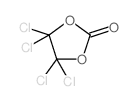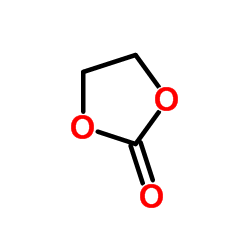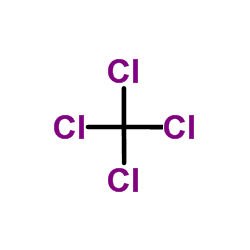22432-68-4
| Name | 4,4,5,5-Tetrachloro-1,3-dioxolan-2-one |
|---|---|
| Synonyms |
Tetrachlor-[1,3]dioxolan-2-on
1,3-Dioxolan-2-one,4,4,5,5-tetrachloro tetrachloro-[1,3]dioxolan-2-one TETRACHLOROETHYLENE CARBONATE |
| Density | 1.93g/cm3 |
|---|---|
| Boiling Point | 223.3ºC at 760mmHg |
| Molecular Formula | C3Cl4O3 |
| Molecular Weight | 225.84200 |
| Flash Point | 99.4ºC |
| Exact Mass | 223.86000 |
| PSA | 35.53000 |
| LogP | 2.41600 |
| Vapour Pressure | 0.0969mmHg at 25°C |
| Index of Refraction | 1.542 |
Synonym: 4,4,5,5-Tetrachloro-1,3-Dioxolan-2-One. SECTION 2 - COMPOSITION, INFORMATION ON INGREDIENTS
Risk Phrases: 22 26 34 SECTION 3 - HAZARDS IDENTIFICATION EMERGENCY OVERVIEW Harmful if swallowed. Very toxic by inhalation. Causes burns.The toxicological properties of this material have not been fully investigated.Corrosive. Potential Health Effects Eye: Causes eye burns. May cause chemical conjunctivitis and corneal damage. Skin: Causes skin burns. May cause skin rash (in milder cases), and cold and clammy skin with cyanosis or pale color.
Ingestion: May cause severe and permanent damage to the digestive tract. Causes gastrointestinal tract burns. May cause perforation of the digestive tract. May cause cardiac disturbances. The toxicological properties of this substance have not been fully investigated. May cause central nervous system depression. May cause systemic effects. Inhalation: Causes chemical burns to the respiratory tract. The toxicological properties of this substance have not been fully investigated. Aspiration may lead to pulmonary edema. May cause cardiac abnormalities. May cause systemic effects. Inhalation at high concentrations may cause CNS depression and asphixiation. Chronic: Effects may be delayed. SECTION 4 - FIRST AID MEASURES Eyes: Get medical aid immediately. Do NOT allow victim to rub eyes or keep eyes closed. Extensive irrigation with water is required (at least 30 minutes). Skin: Get medical aid immediately. Immediately flush skin with plenty of water for at least 15 minutes while removing contaminated clothing and shoes. Wash clothing before reuse. Destroy contaminated shoes. Ingestion: Do not induce vomiting. If victim is conscious and alert, give 2-4 cupfuls of milk or water. Never give anything by mouth to an unconscious person. Get medical aid. Get medical aid immediately. Do NOT induce vomiting. If conscious and alert, rinse mouth and drink 2-4 cupfuls of milk or water. Inhalation: Get medical aid immediately. Remove from exposure and move to fresh air immediately. If breathing is difficult, give oxygen. Do NOT use mouth-to-mouth resuscitation. If breathing has ceased apply artificial respiration using oxygen and a suitable mechanical device such as a bag and a mask. Notes to Physician: SECTION 5 - FIRE FIGHTING MEASURES General Information: As in any fire, wear a self-contained breathing apparatus in pressure-demand, MSHA/NIOSH (approved or equivalent), and full protective gear. During a fire, irritating and highly toxic gases may be generated by thermal decomposition or combustion. Vapors may be heavier than air. They can spread along the ground and collect in low or confined areas. Contact with metals may evolve flammable hydrogen gas. Containers may explode when heated. Non-combustible, substance itself does not burn but may decompose upon heating to produce irritating, corrosive and/or toxic fumes. Runoff from fire control or dilution water may cause pollution. Extinguishing Media: Use water spray to cool fire-exposed containers. For small fires, use dry chemical, carbon dioxide, or water spray. For large fires, use dry chemical, carbon dioxide, alcohol-resistant foam, or water spray. SECTION 6 - ACCIDENTAL RELEASE MEASURES General Information: Use proper personal protective equipment as indicated in Section 8. Spills/Leaks: Absorb spill with inert material (e.g. vermiculite, sand or earth), then place in suitable container. Avoid runoff into storm sewers and ditches which lead to waterways. Clean up spills immediately, observing precautions in the Protective Equipment section. Provide ventilation. SECTION 7 - HANDLING and STORAGE Handling: Wash thoroughly after handling. Use only in a well-ventilated area. Do not breathe dust, vapor, mist, or gas. Do not get in eyes, on skin, or on clothing. Keep container tightly closed. Do not ingest or inhale. Discard contaminated shoes. Storage: Keep container closed when not in use. Store in a tightly closed container. Store in a cool, dry, well-ventilated area away from incompatible substances. Corrosives area. SECTION 8 - EXPOSURE CONTROLS, PERSONAL PROTECTION Engineering Controls: Facilities storing or utilizing this material should be equipped with an eyewash facility and a safety shower. Use adequate ventilation to keep airborne concentrations low. Exposure Limits CAS# 22432-68-4: Personal Protective Equipment Eyes: Wear appropriate protective eyeglasses or chemical safety goggles as described by OSHA's eye and face protection regulations in 29 CFR 1910.133 or European Standard EN166. Skin: Wear appropriate protective gloves to prevent skin exposure. Clothing: Wear appropriate protective clothing to prevent skin exposure. Respirators: Follow the OSHA respirator regulations found in 29 CFR 1910.134 or European Standard EN 149. Use a NIOSH/MSHA or European Standard EN 149 approved respirator if exposure limits are exceeded or if irritation or other symptoms are experienced. SECTION 9 - PHYSICAL AND CHEMICAL PROPERTIES Physical State: Liquid Color: clear amber Odor: None reported. pH: Not available. Vapor Pressure: 2 Pa @ 20 C Viscosity: Not available. Boiling Point: 164 deg C @ 760.00mm Hg Freezing/Melting Point: -17 deg C Autoignition Temperature: > 835 deg C (> 1,535.00 deg F) Flash Point: > 110 deg C (> 230.00 deg F) Explosion Limits, lower: Not available. Explosion Limits, upper: Not available. Decomposition Temperature: Solubility in water: reacts Specific Gravity/Density: 1.7100g/cm3 Molecular Formula: C3Cl4O3 Molecular Weight: 225.84 SECTION 10 - STABILITY AND REACTIVITY Chemical Stability: Stable under normal temperatures and pressures. Conditions to Avoid: Incompatible materials, excess heat, strong oxidants. Incompatibilities with Other Materials: Oxidizing agents. Hazardous Decomposition Products: Hydrogen chloride, carbon monoxide, irritating and toxic fumes and gases, carbon dioxide. Hazardous Polymerization: Has not been reported. SECTION 11 - TOXICOLOGICAL INFORMATION RTECS#: CAS# 22432-68-4 unlisted. LD50/LC50: Not available. Carcinogenicity: Tetrachloroethylene Carbonate - Not listed by ACGIH, IARC, or NTP. SECTION 12 - ECOLOGICAL INFORMATION SECTION 13 - DISPOSAL CONSIDERATIONS Dispose of in a manner consistent with federal, state, and local regulations. SECTION 14 - TRANSPORT INFORMATION IATA Shipping Name: TOXIC LIQUID, CORROSIVE, ORGANIC, N.O.S. Hazard Class: 6.1 (8) UN Number: 2927 Packing Group: II IMO Shipping Name: TOXIC LIQUID, CORROSIVE, ORGANIC, N.O.S. Hazard Class: 6.1 (8) UN Number: 2927 Packing Group: II RID/ADR Shipping Name: TOXIC LIQUID, CORROSIVE, ORGANIC, N.O.S. Hazard Class: 6.1 UN Number: 2927 Packing group: II SECTION 15 - REGULATORY INFORMATION European/International Regulations European Labeling in Accordance with EC Directives Hazard Symbols: T+ C Risk Phrases: R 22 Harmful if swallowed. R 26 Very toxic by inhalation. R 34 Causes burns. Safety Phrases: S 9 Keep container in a well-ventilated place. S 26 In case of contact with eyes, rinse immediately with plenty of water and seek medical advice. S 28A After contact with skin, wash immediately with plenty of water. S 36/37/39 Wear suitable protective clothing, gloves and eye/face protection. S 37 Wear suitable gloves. S 45 In case of accident or if you feel unwell, seek medical advice immediately (show the label where possible). WGK (Water Danger/Protection) CAS# 22432-68-4: No information available. Canada CAS# 22432-68-4 is listed on Canada's DSL List. CAS# 22432-68-4 is not listed on Canada's Ingredient Disclosure List. US FEDERAL TSCA CAS# 22432-68-4 is not listed on the TSCA inventory. It is for research and development use only. SECTION 16 - ADDITIONAL INFORMATION MSDS Creation Date: 9/02/1997 Revision #5 Date: 3/18/2003 The information above is believed to be accurate and represents the best information currently available to us. However, we make no warranty of merchantability or any other warranty, express or implied, with respect to such information, and we assume no liability resulting from its use. Users should make their own investigations to determine the suitability of the information for their particular purposes. In no way shall the company be liable for any claims, losses, or damages of any third party or for lost profits or any special, indirect, incidental, consequential or exemplary damages, howsoever arising, even if the company has been advised of the possibility of such damages. SECTION 16 - ADDITIONAL INFORMATION N/A |
| Hazard Codes | T+: Very toxic; |
|---|---|
| Risk Phrases | 22-26-34 |
| RIDADR | UN 1760 |
| Packaging Group | III |
| HS Code | 2932999099 |
|
~% 
22432-68-4 |
| Literature: US2816287 , ; |
|
~% 
22432-68-4 |
| Literature: US2816287 , ; |
| Precursor 3 | |
|---|---|
| DownStream 1 | |
| HS Code | 2932999099 |
|---|---|
| Summary | 2932999099. other heterocyclic compounds with oxygen hetero-atom(s) only. VAT:17.0%. Tax rebate rate:13.0%. . MFN tariff:6.5%. General tariff:20.0% |



